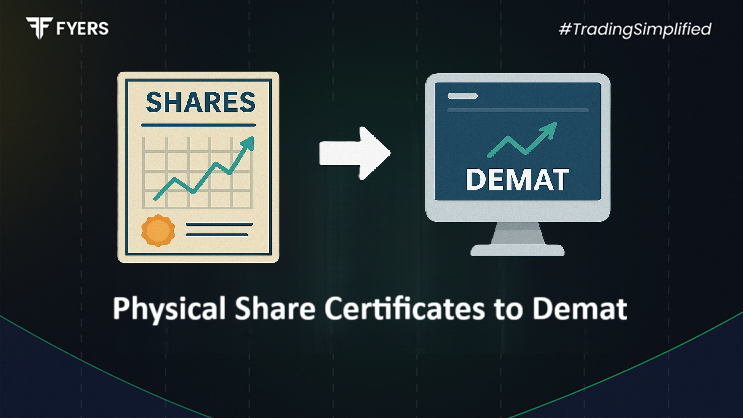

 17 Sep, 2025
17 Sep, 2025
 4 mins read
4 mins read

The Indian stock market has undergone a major transformation over the past two decades. Gone are the days when investors received physical share certificates as proof of ownership. Today, most transactions happen electronically through dematerialised accounts (demat accounts). However, many investors still hold shares in paper form, and converting them into electronic format is not just beneficial but also necessary for trading. This guide explains how to convert a share certificate to demat, the documents you’ll need, costs involved, and the benefits of holding shares in dematerialised form.
Physical share certificates are paper documents issued by a company that serve as legal proof of share ownership. Each certificate typically contains details such as the investor’s name, the number of shares held, certificate number, and the company’s seal.
In the past, these paper-based certificates were the standard. But they came with risks such as loss, theft, damage, or forgery. With the introduction of electronic systems and the rise of demat share certificates, physical stock certificates are gradually being phased out.
Holding shares in physical form is no longer practical. Since April 2019, SEBI (Securities and Exchange Board of India) has made it mandatory to transfer securities only in demat form. This means you cannot sell or transfer shares if they are still in paper format.
Key reasons for conversion include:
Compliance: Regulatory requirement for trading or transferring shares.
Security: Reduced risk of damage, theft, or loss of documents.
Convenience: Faster transactions and easier portfolio tracking.
Liquidity: Easier to sell or pledge shares when needed.
To initiate the conversion of share certificates in physical form, you’ll need:
Original physical share certificates.
A duly filled Dematerialisation Request Form (DRF).
A demat account with a Depository Participant (DP).
Self-attested copies of identity proof (PAN card, Aadhaar, passport, etc.).
Proof of address (utility bill, driving licence, etc.).
Recent passport-sized photographs (if required by the DP).
The procedure for converting paper shares to demat is straightforward, provided you follow the correct steps:
Approach a Depository Participant (DP), such as a bank or brokerage firm, and open a demat account. This account will hold your shares electronically.
Obtain the DRF from your DP. Fill in details such as company name, certificate number, and the number of shares. Attach the original physical stock certificates along with the form.
Hand over the filled DRF and physical certificates to your DP. Ensure the certificates are not mutilated and the names on the certificates match your demat account.
The DP forwards your documents to the company’s Registrar and Transfer Agent (RTA). The RTA verifies ownership details and confirms the validity of the request.
Once verification is successful, the RTA instructs the depositories (NSDL or CDSL) to credit the shares into your demat account. The entire process usually takes 2–4 weeks.
The charges for converting a share certificate to demat vary by DP but usually include:
Processing fees: ₹100–₹500 per request.
Courier/handling charges: Nominal costs depending on the DP.
Annual maintenance charges (AMC): Ongoing charges for holding a demat account.
On average, the conversion process takes between 15 and 30 days, depending on the efficiency of the DP and RTA.
Switching from physical share certificates to demat offers multiple advantages:
Safety: Eliminates risks of theft, forgery, or loss.
Easy transfer: Shares can be transferred quickly with just a few clicks.
Portfolio management: Investors can track and manage holdings online.
Corporate benefits: Dividends, bonuses, and rights issues are directly credited to your account.
Cost savings: Reduced paperwork and stamp duty on transfers.
Investors may face hurdles while converting paper shares to demat. Some common issues include:
Mismatch in signatures: If your signature differs from company records, you’ll need to update it.
Name mismatch: Minor differences (e.g., spelling errors) may require an affidavit or name correction request.
Lost or damaged certificates: You may need to apply for a duplicate share certificate before dematerialisation.
Dormant companies: If the company is inactive, conversion may not be possible until legal matters are resolved.
With regulators mandating electronic form for trading and transfers, holding share certificates in physical form is no longer feasible. Converting them into demat ensures safety, convenience, and compliance. By following the step-by-step process, arranging the right documents, and working with a reliable Depository Participant, investors can safeguard their wealth and make their investments future-ready.
Yes, but you cannot sell or transfer them. Conversion to demat is mandatory for trading.
The process usually takes 2–4 weeks, depending on your DP and registrar.
You will need the original certificates, a filled DRF, ID/address proof, and a demat account.
Charges vary by DP but typically range from ₹100–₹500 per request, plus AMC for the demat account.
Calculate your Net P&L after deducting all the charges like Tax, Brokerage, etc.
Find your required margin.
Calculate the average price you paid for a stock and determine your total cost.
Estimate your investment growth. Calculate potential returns on one-time investments.
Forecast your investment returns. Understand potential growth with regular contributions.